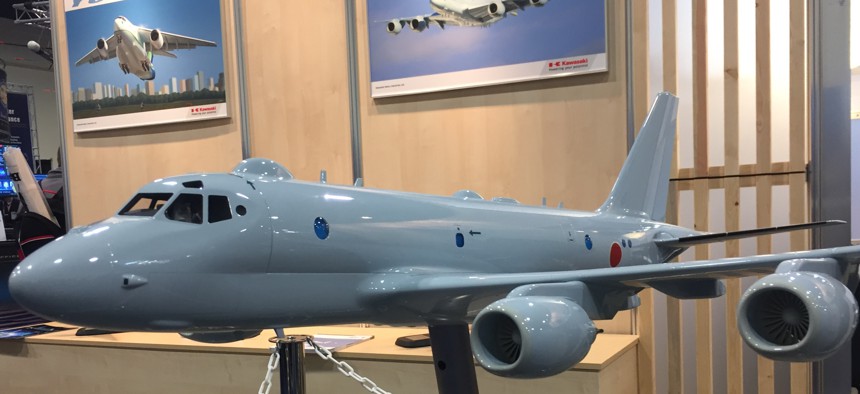
A model of the Kawasaki P-1 on display at the Navy League's Sea-Air-Space conference in National Harbor, Maryland. Marcus Weisgerber/Defense One
Japan Shops Futuristic Sub-Hunter Plane
With arms export ban loosened, Tokyo is shopping an indigenous sub-hunting plane for the first time at an American arms show.
It looks like a Japanese Shinkansen bullet train with wings. Two round bubbles and sharp antennas jut from its spine and underbelly. But this is no 737 people mover. It’s Kawasaki’s new P-1 submarine-hunting airplane, the first of its kind Japan has shown to foreign buyers after loosening World War II-era arms exports restrictions. And it’s a doozy.
Kawasaki reps are in the U.S. this week, showing off a small model of the plane at the Navy League’s annual Sea-Air-Space conference, a mass gathering of American and foreign naval officials. Company officials have hooked the sound of its roaring engines into a small Bose speaker strapped to the model’s base, drawing the attention of passers by.
The display inside a massive conference center just outside the Washington Beltway marks the first time Kawasaki has showcased the plane at an American trade show, a company rep said. Japan modified its constitution in 2014, allowing Tokyo to export arms for the first time since World War II. Kawasaki pitched the P-1 at an arms show in Japan last summer.
As China and North Korea step up their submarine patrols, maritime surveillance aircraft are in demand.
“In 2015, China continued the trend of conducting submarine deployments to the Indian Ocean, ostensibly in support of its counterpiracy patrols,” the Pentagon said last week in its annual assessment of Beijing’s military.
Kawasaki is billing the P-1 as a replacement for the Lockheed P-3 Orion, a plane flown in the Asia-Pacific by Japan, Australia, South Korea, New Zealand, Taiwan, and Thailand.
The U.S. military is replacing its own P-3s with the P-8 Poseidon, a sub-hunting plane based on Boeing’s 737 jetliner. India is also buying the P-8 and the U.K. is planning to place an order for the first of nine P-8s this summer.
The company rep at the Sea-Air-Space show didn’t list any specific countries they were targeting for sales. Next to the model airplane were glossy brochures with pictures, performance data and comparison charts, akin to the marketing material distributed by American firms.
“The P-1 is a [Japanese Maritime Self Defense Force] long-range, long-endurance anti-submarine warfare maritime patrol aircraft which provides superiority in the territorial waters and coastal regions of Japan,” one brochure reads.
The plane’s “large windshields and bubble windows enables superior visibility,” reads another page, above a picture of a Japanese P-1 taking off. “The P-1 is especially suited for low-altitude [anti-submarine warfare] with its large wing and spacious fuselage."
And it can pack some firepower too: bombs, missiles, torpedoes, and mines fit inside an internal weapons bay or can be strapped to its wings.
Japan launched the P-1 project in 2001. The plane flew for the first time in 2007 and Japan has been has been flying the P-1 operationally since 2013. Japan’s P-1s are replacing its own P-3s, which were built by Kawasaki under license from Lockheed. Japan plans to have at least 28 P-1s by the end of the decade and 70 by 2027.
In the brochure, Kawasaki has a picture of a P-1 flying alongside a P-3 with a snow-capped Mount Fuji in the background. Perhaps a metaphor for the steep hill the plane has to climb to lock down some foreign sales.




